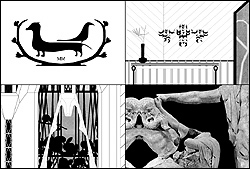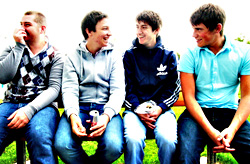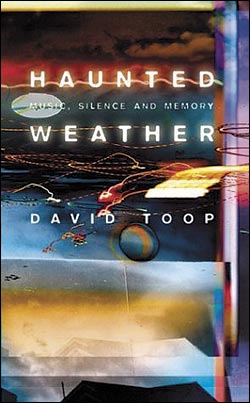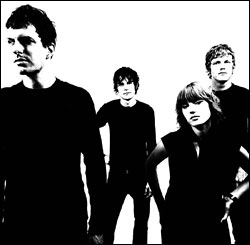Lansing-Dreiden are the anti-Strokes. Sure, they have a few things in common—cheddar in the woodpile, atavistic gestures, New York—but the essence of each band’s mission differs nearly as much as the results. Constantly honing their chops, carefully writing carefully written songs with care, and generally realizing every worthy cliché in the genre job log while cultivating a complex, compelling mystique—Julian Casablancas and crew make ducky stanchion-bearing Whippenpoofs for rock’s rump state. So what if they’re taking Tiger Mountain by the numbers? Like Pepsi, the Strokes are the real thing. Ask Lou Reed. He’d never grace the cover of Alternative Press with Lansing-Dreiden. “Who are these guys?” he’d protest. “I can’t even find them!” No photos? No interviews? No live shows? Bad, zero-commodity value, invisible Lansing-Dreiden! How can you help reinvent the wheel when you don’t even call yourselves a band?
The conundrum wasn’t always so knotty. As recently as December 2001, the designation “Lansing-Dreiden” applied to a group of visual artists—one of whom was Jorge Elbrecht. The Miami native and Columbia student (at the time) also led the Lines, a rock quartet that, typically enough, played out fairly often. Only in 2002 was the band fully assimilated by what, in its words, had become “a company that sees no distinction between art and commerce.”
Most sensible folk dismissed the assertion—along with the rest of the spiel surrounding The Incomplete Triangle, Lansing-Dreiden’s 2003 audio debut—as inconsequential neo-PIL dook. Oops! While it’s unlikely that the company will be tearing the roof off the NYSE at any point before 2012, the artists do a bunch of things well. Drawing on sources ranging from the Arts and Crafts movement to ’50s high advertising style, their gallery and graphic work blurs the line between fine art and illustration in a subtle, intriguing manner. Their video output is handsomely enigmatic. Death Notice— L-D’s intermittently published magazine—owes McSweeney’s, but offers more cheek and extra tongue to put in it.
Dabblers they’re not. For all its visible nuts and bolts, The Incomplete Triangle was a monstrously charming concoction, an oversized Huck Finn raft of an album gamboling among the dinghies in rock’s turgid river with near-suicidal abandon. Besides, the album afforded ample oppor-tunity for “spot the novel juxtaposition” geeks; everyone should have an occasion to call something “a cross between Talking Heads and the Electric Prunes” at least once in his or her life.
A Sectioned Beam (Kemado) is a more seaworthy affair and more mysterious. No matter how deeply they plumb the EP’s four songs, musical forensics specialists will find next to naught to hang their clipboards on. The marriage of ’60s curves and ’80s angles that informed Lansing-Dreiden’s debut holds, but the little scamps have scraped the serial numbers off all the parts and rebuilt everything to seem like it’s from the 2060s and 1880s. Not even Alberto Gonzales could build a case against them with the evidence at hand.
Sure, something a little old and borrowed juts out from under the disc’s newly chromed surface every now and then—the single, late–Tim Buckley chord that the halves of opening track “Locks in Shadows” revolve around like the arms of a spiral nebula, for instance. It’s a singularity; the rest of the song bubbles with the kind of velvet-frock-coated ebullience that could have landed the band (let’s call them that, just for simplicity’s sake) on Ed Sullivan in 1966, except the vocals are way too weirdly futuristic, curling around crisp guitars and bouncy organ like mauve smoke in a DPT hallucination. “Spectrum of Vapor” takes a tiny melodic sliver of Jay and the Americans’ “She Cried” and fashions it into an oceanic reflection on our relationship with nature.
But the title track is clean, with one exception, unless you’re inclined to attribute the song’s cowbell part to Barry White’s “Your Sweetness Is My Weakness”—a stretch, given its near-universal simplicity. Still, disco figures into the L-D equation, however obliquely. “A Sectioned Beam” has a central theme that floats like a Love Unlimited Orchestra strings chart transposed for guitar over a doubled-up hustle beat. The unalloyed joy doesn’t last long; both verse and wickedly minimal guitar solo are buttressed with a tri-tone–based pattern naughty enough to make Mephistopheles cop a rock Travolta—even before Byzantine voices proclaim that his is not the only game in town. Not even great Satan himself could ever imagine stealing the Association’s flow, as Lansing-Dreiden do on the last two lines of “The learn-ed alphabet/Of the occurring song/Of rites and rituals we hunger for/And only want to take from.” “Along Comes Lilith?” Who cares? They should get fucking salvage rights! Plus, the utterly unearthly vocal figure eight that closes the track more than makes up for the theft; the thing sounds the way a binary star might smell.
“A Sectioned Beam” (as well as A Sectioned Beam) reads more like a manifesto than anything the band (of merry artists) have issued in print to date, which is to say, quite a lot. Lansing-Dreiden are fabulists at heart, bent on fashioning ever more unlikely worlds out of a few scraps of past and the effluvia of their own feverish imaginations. That’s where they really differ from the Strokes, whose future is pretty much written in stone: They’ll continue to become a better rock band, make at least one album that sells more than 500,000 copies, as well as an “electronic” one, and eventually dissolve. With Lansing-Dreiden, who knows? And what does it matter? When you meet a unicorn in your backyard, you don’t ask where it’s going.
Lansing-Dreiden Section play El Corazon with the Turn Ons, DJ Pedro, and DJ Steven at 8 p.m. Sat., Feb. 5. $10.








